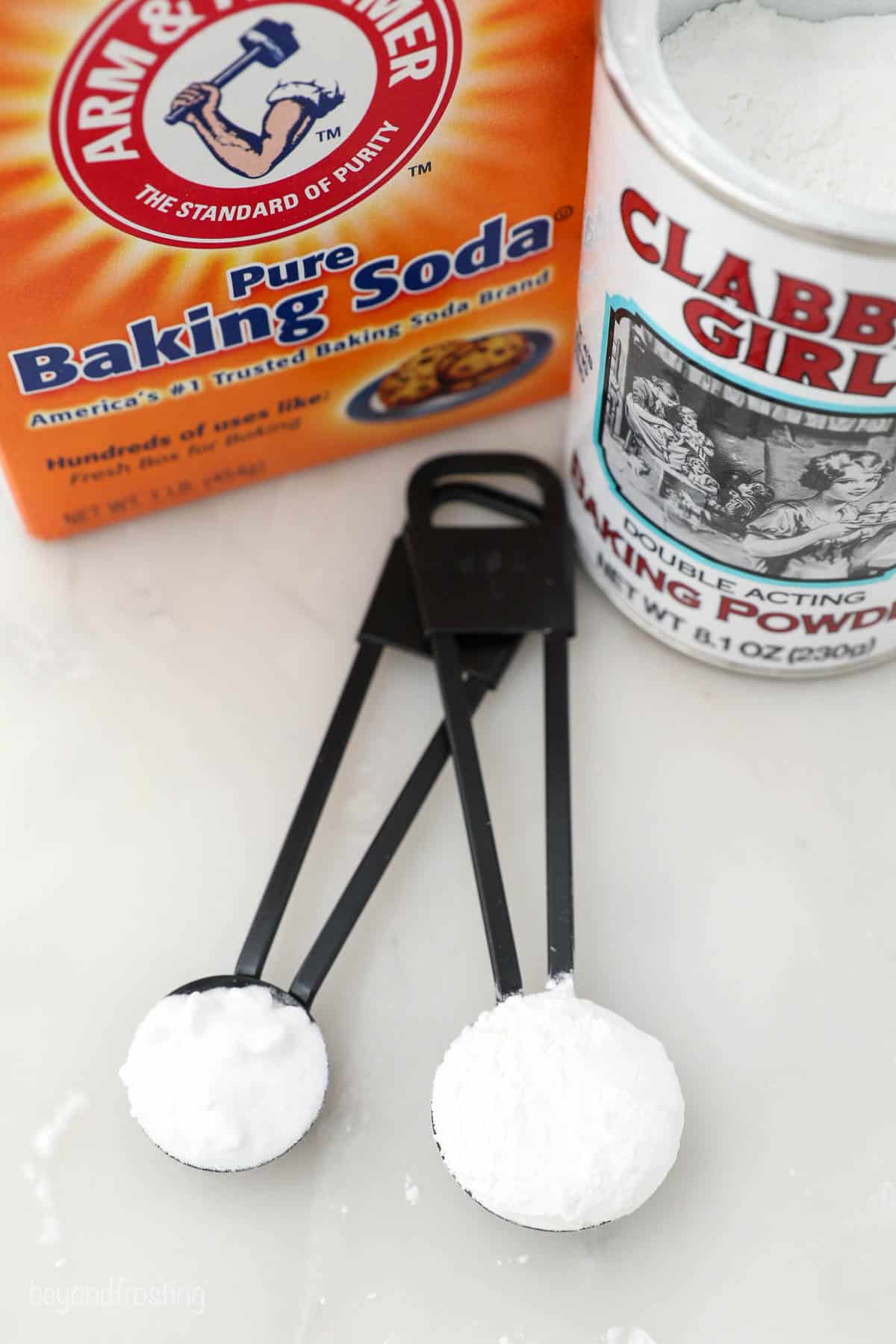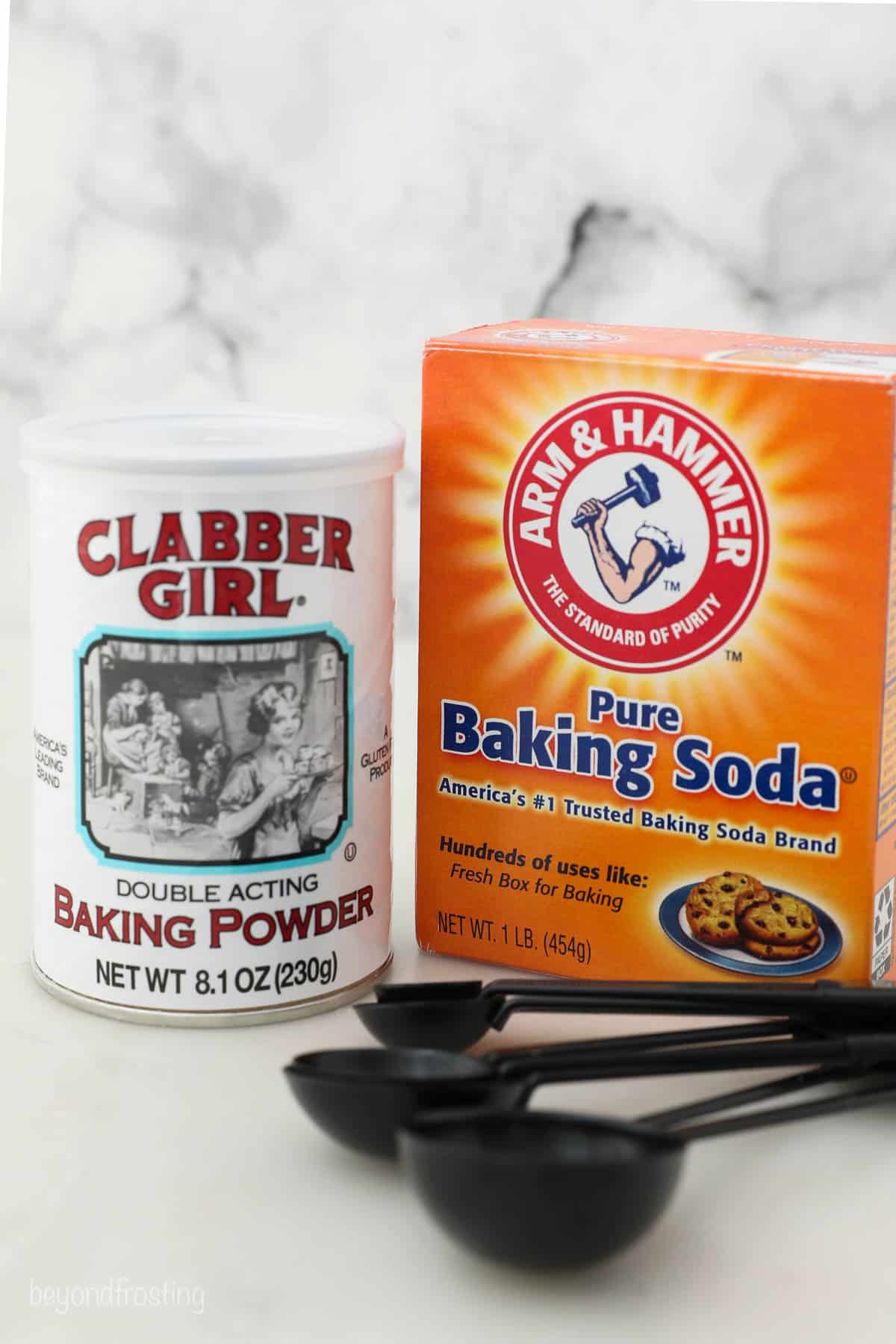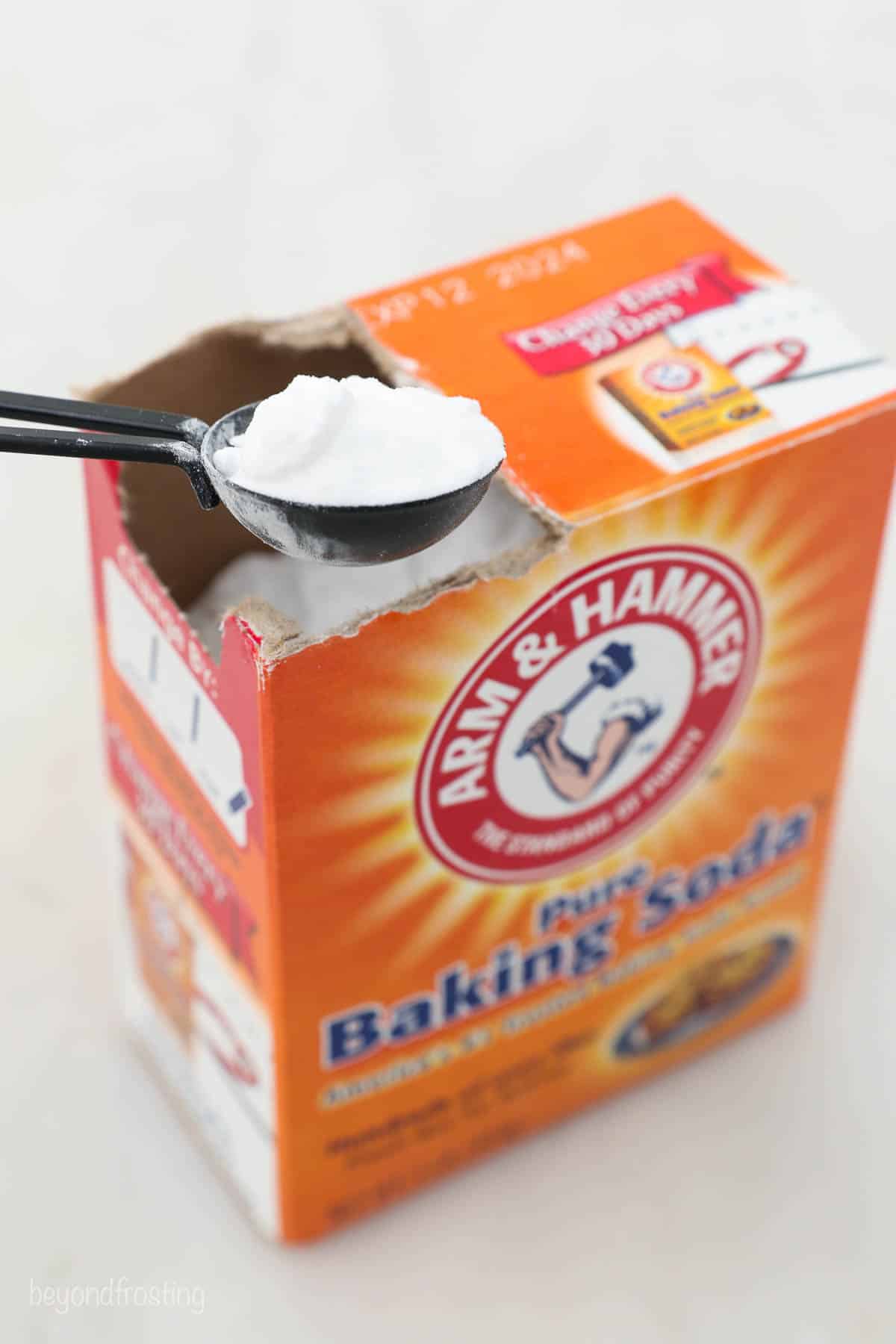You probably know that baking soda and baking powder both contribute to the rise of baked goods, but it’s important to understand how they’re different from one another. This comprehensive guide will teach you everything you need to know about Baking Soda vs Baking Powder!

Learn Your Leavening Agents – Baking Soda vs Baking Powder
Every baked good that’s meant to rise in the oven requires a leavening agent to produce that fluffy texture you know and love. The most confusing thing about leavening agents can be summed up in one age-old question – What is the difference between baking soda and baking powder?
Well, that’s exactly the mystery we’re going to solve today. Buckle in and get ready for a good old-fashioned chemistry lesson.
How Do Leavening Agents Work?
Leavening agents like baking soda and baking powder work by releasing carbon dioxide – the same gas that humans exhale when they breathe. This carbon dioxide bubbles up inside cookies, cakes, and brownies, creating lift and rise during the baking process. Not only does the chemical reaction make for fluffy baked goods, but it also creates tenderness in the process.
If you’ve ever had a baked good come out flat, there was likely an issue regarding the leavening agent. Perhaps you used baking powder instead of baking soda, or perhaps the recipe called for the wrong amount of either one. It is even possible your leavening agent has expired. Let’s discuss both of these kitchen staples in detail so that you never run into such an issue again.

What is Baking Soda?
Scientifically known as sodium bicarbonate, baking soda is a basic compound that requires an acidic element to release carbon dioxide and create rise. Any acidic ingredient will trigger this reaction, from applesauce to buttermilk to brown sugar. The right ratio of baking soda to acid will not alter the flavor of your baked good – only the texture.
With the wrong ratio (or with no acid present), your baked good would develop an undesirable metallic aftertaste. To prevent this, you must have enough acidity in your batter or dough to fully activate the baking soda.
When to Use It
Since baking soda requires an acid to make it work, you should never use it in a recipe with no acidic ingredients. If you did, it would only add that metallic aftertaste mentioned above. Here are some additional ingredients that will react with baking soda:
- Honey
- Molasses
- Lemon Juice
- Natural Cocoa Powder (Not Dutch processed cocoa powder)
- Sour Cream
- Vinegar
- Unsweetened Chocolate
What Does Baking Soda Do In Cookies?
With an understanding of what baking soda is, here’s what’s happening behind the scenes when you add baking soda to cookie dough:
- Leavening – When combined with cookie dough, baking soda releases carbon dioxide. This reaction helps the cookies rise up in the oven, resulting in that soft, light texture we know and love.
- Browning – Baking soda also helps the cookies brown while baking, as it speeds up what’s called the Maillard reaction. This reaction is what caramelizes the sugars to create those crisp, browned edges.
- Spreading – Cookies made with baking soda will spread more, and they’ll take longer to set.
Pretty neat, huh? Certain recipes, like chocolate chip cookies, for example, can get away without baking soda in a pinch. But if a recipe calls for it, do your best not to skip it.

What is Baking Powder?
Baking powder is a combination of baking soda and cream of tartar (as well as cornstarch in certain cases). Since cream of tartar is an acid, baking powder produces rise all by itself. The majority of baking powders are double-acting, which means they create this rise on two separate occasions.
The first rise occurs when the baking powder is exposed to moisture (i.e. when it’s combined with wet ingredients). After that initial rise, baking soda gets a second wind during the baking process.
What Does Baking Powder Do?
Similar to baking soda, baking powder also reacts with the moisture in cookie dough. Double-action baking powder is the most common type sold in grocery stores. Double acting means that the baking powder dissolves into the wet dough and, when exposed to the heat in the oven, releases air bubbles that give the finished cookies a light, fluffy texture. I recommend using baking powder whenever you want cookies with a bit of lift, or whenever a recipe calls for creaming together butter and sugar.
When to Use It
Even though there’s baking soda in baking powder, the two leavening agents are typically used in opposite scenarios. If you’re baking something that doesn’t call for an acidic ingredient, baking powder is the way to go. You won’t be left with any aftertaste since it contains its own acid to begin with.
However, you can still use baking powder in recipes that call for an additional acid. For example, if you’re making red velvet cupcakes, you want that touch of tang from the buttermilk and/or vinegar. So you wouldn’t want to cancel out all of the acidity with the corresponding ratio of baking soda. In that case, baking powder is a good choice even though the batter will contain a separate acid.
What About Aluminum-Free Baking Powder?
Aluminum-free baking powder is not double-acting, so it only creates a rise when it’s exposed to moisture. No additional rise will occur in the oven. Because of this, aluminum-free baking powder should be avoided for recipes that require the resting of the dough or batter.

Why Do Some Recipes Call For Both?
There are plenty of recipes that use both baking soda and baking powder. Let’s refer back to the previous example of my red velvet cupcake.
If you clicked on the recipe, you may have noticed that it calls for both leavening agents. Further examination of the ingredients will reveal that there are 3 different acids used in the cake batter – vinegar, natural cocoa powder, and buttermilk. Baking soda helps to balance out all of that acid without getting rid of the intended tanginess.
Since baking powder includes its own acid, it’s often added to recipes that call for baking soda to provide some extra tang. Some baked goods could simply use the extra lifting power. It really depends on what you’re making and what the intended result is.
Can I Substitute One For the Other?
All of my recipes have undergone extensive testing, so there’s no need to try substituting baking soda for baking powder or vice versa. Messing around with leavening agents requires a lot of trial and error that not everyone is looking to take on in their daily lives. It’s best to keep your kitchen stocked with both baking soda and baking powder so that you’re prepared for any recipe that piques your interest.

Do Leavening Agents Have a Shelf Life?
Just like any other ingredient, leavening agents indeed have a shelf life. I like to replace my baking soda and baking powder every 3 months or so.
Not sure how long you’ve had your leavening agents for? You can easily determine their effectiveness with these simple tests:
- For Baking Soda: Lightly stir half a teaspoon of baking soda into 3 tablespoons of distilled white vinegar. If the mixture bubbles, your baking soda is effective. If nothing happens, it’s time to hit the grocery store.
- For Baking Powder: Lightly stir half a teaspoon of baking powder into 3 tablespoons of warm water. A fizzy mixture indicates that the baking powder is fresh. No reaction means it’s time to replace it.
More Tips & Tricks to Guide You in the Kitchen
There you have it! I hope you liked learning about baking soda vs baking powder. Be sure to click the links below if you’re interested in more helpful cooking and baking advice.





